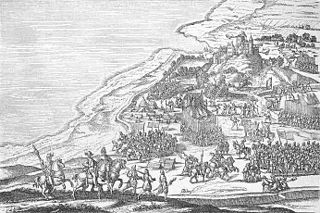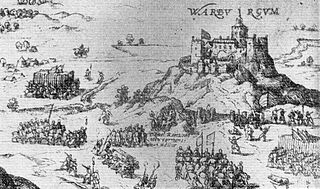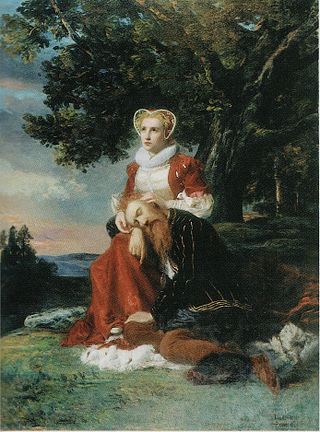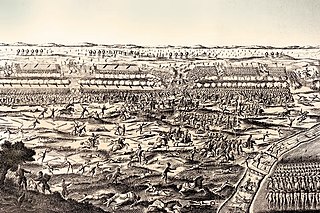
Halland is one of the traditional provinces of Sweden (landskap), on the western coast of Götaland, southern Sweden. It borders Västergötland, Småland, Scania and the sea of Kattegat. Until 1645 and the Second Treaty of Brömsebro, it was part of the Kingdom of Denmark. Its name means Land of Rocky Slabs referring to the coastal cliffs of especially the northern part of the region.

Falkenberg is a locality and the seat of Falkenberg Municipality, Halland County, Sweden, with 27,813 inhabitants in 2019. It is located at the mouth of river Ätran. The name consists of the Swedish words for falcon (falk) and mountain (berg). Falkenberg is a popular tourist destination in the summers, and the main beach of the town is Skrea strand.

The Northern Seven Years' War was fought between the Kingdom of Sweden and a coalition of Denmark–Norway, Lübeck, and Poland–Lithuania between 1563 and 1570. The war was motivated by the dissatisfaction of King Frederick II of Denmark with the dissolution of the Kalmar Union, and the will of King Eric XIV of Sweden to break Denmark's dominating position. The fighting continued until both armies had been exhausted, and many men died. The resulting Treaty of Stettin was a stalemate, with neither party gaining any new territory.

The Count's Feud, also called the Count's War, was a war of succession that raged in Denmark in 1534–36 and brought about the Reformation in Denmark. In the international context, it was part of the European wars of religion. The Count's Feud takes its name from the Protestant Count Christopher of Oldenburg, who supported the Catholic King Christian II, deposed in 1523, over the election of Christian III, a staunch Protestant who had already implemented Lutheranism as the state religion in Schleswig and Holstein in 1528.

The Scanian War was a part of the Northern Wars involving the union of Denmark–Norway, Brandenburg and Sweden. It was fought from 1675 to 1679 mainly on Scanian soil, in the former Danish–Norwegian provinces along the border with Sweden, and in Northern Germany. While the latter battles are regarded as a theater of the Scanian war in English, Danish, Norwegian and Swedish historiography, they are seen as a separate war in German historiography, called the Swedish-Brandenburgian War.

JohanRantzau was a German-Danish general and statesman known for his role in the Count's Feud. His military leadership ensured the succession of Christian III to the throne, which brought about the Reformation in Denmark.

Daniel Rantzau was a Danish-German general. He was known for his leadership during the Northern Seven Years' War. For some years, he fought in Germany and Italy, and also took part in the Danish conquest of Dithmarschen in western Holstein during 1559. Rantzau also seems to have been a clear pro-war spokesman before the outbreak of the Northern Seven Years' War with Sweden in 1563.
The Military timeline of Denmark is centered around an involvement in wars in Northern Europe since 793 and, recently, elsewhere.

Köinge is a village in Falkenberg Municipality, Sweden. It formed a separate parish until 2005, when it became a part of Okome parish. The village has about 200 inhabitants.

The Battle of Helsingborg was the last major engagement of the Great Northern War to take place on Swedish soil, and resulted in a decisive victory of a Swedish force of 14,000 men under the command of Magnus Stenbock against a Danish force of equal strength under the command of Jørgen Rantzau, ensuring that Denmark's final effort to regain the Scanian territories that it had lost to Sweden in 1658 failed. The battle was fought on March 10, 1710, in the province of Scania, just outside the city of Helsingborg, and directly on the Ringstorp heights just north-east of the city.

The Falkenberg Bridge is a stone arch bridge in Falkenberg, Sweden, built between 1756 and 1761. The bridge spans the Ätran river and is a listed building since 1984. It underwent major repair and restoration works in 1927 and 1994. The bridge is still in use and is used by an average of 3,800 vehicles a day. It was a toll bridge until 1914. The ruin of the fort Falkenberg is located close to the bridge, at the southern strand. The bridge has given its name to the nearby Tullbroskolan high school.
The military history of Norway commences before the Viking Age with the internal wars fought between regional kings to obtain the supreme kingship of the whole of Norway. The most famous period of Norwegian history and thus military history is the Viking Age, but the early Middle Ages was the era when Norwegian military power in Europe reached its peak. Since then the Norwegian military has experienced long periods of neglect, but also rearmament and victories.
The Battle of Brobacka was fought in Alingsås between Sweden and Denmark on 9 August 1566. The Swedish army under command of Charles de Mornay successfully managed to ambush Daniel Rantzau and his Danish army on their arrival back from their looting train in Västergötland, southwest of Sweden.
Events from the 1560s in Denmark.

The siege of Varberg was a Danish siege of the Swedish-occupied castle of Varberg in Halland, present-day Sweden by Danish forces under the Danish-German general Daniel Rantzau. Rantzau was killed by a Swedish cannonball on 11 November. Danish commander Franz Brockenhuus and Swedish commander Bo Birgersson Grip were also killed in the battle.

Events from the year 1567 in Sweden

The following events occurred in the year 1568 in Sweden.

Events from the year 1565 in Sweden
The Battle of Wismar took place on December 5, 1711 close to Wismar, Swedish Empire during the Great Northern War. A 3,000 strong Danish force under the command of Jørgen Rantzau blocked the Swedish city of Wismar. The Swedes under Martin von Schoultz, sent out 2,500 men from their garrison in an attempt to surprise the Danish forces camping a distance away. However, the Danish commander got words of the approaching Swedes and countered them, resulting in 478 Swedes dead, with another 1,500 captured to only 300 Danes killed and wounded.

The Bohus Bang, as it is traditionally called in Swedish historiography, was a devastating explosion which occurred at Bohus Fortress in March 1566, during an assault by Swedish forces. The explosion was deliberately triggered by the fortress's Danish-Norwegian defenders in order to destroy the so-called 'Red Tower', which had been captured by the Swedes.
















